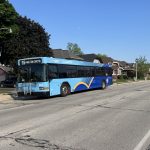Road Map: Assessing and Funding Wisconsin’s Transportation Needs
Wisconsin policymakers are nearing a crossroads on how to fund the state’s transportation system, as transportation revenues lag, project costs sharply increase, and a growing reliance on the state’s general fund may prove unsustainable, a new Wisconsin Policy Forum report finds.
Mounting transportation budget constraints are linked to slow growth in revenue, aging infrastructure, inflation, and other factors. Thus, if policymakers wish to put the state transportation budget on a sustainable path, they likely will face difficult decisions involving real tradeoffs.
“Either the state will have to forego spending and sacrifice road quality over time, or it will have to tap one of a few available funding sources such as the gas tax, vehicle fees, general tax dollars, mileage fees, or local taxes and fees” the report finds.
Lagging transportation revenues; mounting costs
Growth in state transportation fund revenues slowed following the 2005 repeal of the state law linking the gas tax rate to inflation. Rates for the fund’s other key revenue source – vehicle registration fees – were increased in 2008 and 2019, but this only partially offset the gas tax trend. Policymakers responded by tapping the state’s general fund, which relies on state income, corporate and sales taxes. From fiscal year 2012 through June 2025, $2.6 billion will have flowed from the general fund to the transportation fund, including $749.7 million in the 2023-25 state budget alone.
A look at other states
Wisconsin’s combined state and local spending averaged $821 per person, compared to the national average of $811, the three most recent years with available Federal Highway Administration data show. Wisconsin ranked 19th in the country and third in spending among a group that also includes five neighboring states. On a per-lane-mile basis, Wisconsin’s spending falls to fourth among its neighbors at $20,166 per mile, well below the national average of $26,203. Notably, the state faces higher costs from snowplowing and the impact of freezing and thawing on pavement.
Compared to its nearest neighbors and the U.S. average, Wisconsin relies more on transportation taxes and fees to fund roads, and less on general tax revenues. States vary in their chosen revenue mix of registration and title fees, tolls, or gas taxes. Wisconsin outpaces its immediate neighbors in its share of total vehicle-related revenues coming from motor fuel taxes, at 53.7%. As of 2022, the state’s gas tax rate ranked 19th, or 8.4% above the national average.
Options for the future
To assist policymakers and the public, the report outlines three spending scenarios for transportation and examines the potential revenue gap for each. Under the first belt-tightening scenario, transportation spending would be reduced across the board and no new revenues would be needed, but projects would also be delayed and road quality would be affected.
Next, we modeled a “shrink the highway program” scenario in which highway and local road aid spending continues increasing at its current pace and spending for highway megaprojects is cut, which overall would require an additional $88 million annually to sustain; and a “fix the roads” scenario, in which highway and local road aids receive larger annual increases and large highway megaprojects are fully funded. This scenario would improve road conditions but require about $413 million per year in additional revenue. We also examine a series of options to boost transportation revenues to close the potential funding gaps under the latter two scenarios. They include:
- Increasing transfers from the state’s general fund, as the state has done in recent budgets. This approach would provide additional funds for roads without increases to taxes and fees paid by drivers. But it would impact other key priorities such as education, health care, and corrections, and also put upward pressure on income and sales taxes.
- Increasing the state’s gas tax and vehicle registration fee. This approach would help keep transportation funding from competing with other state priorities. However, vehicle registration fees were increased relatively recently (in 2019). A gas tax increase would link costs for motorists with how much they drive, but such increases fall more heavily on rural residents and generally have proven unpopular.
- With the long-term outlook for the gas tax murky amid the rise of electric vehicles, state leaders could choose to consider a mileage-based fee on motorists. Thus far, this approach has only been implemented on a limited scale in Oregon, Utah, and Virginia. These little-used programs show mileage-based fees are technologically feasible, but remain relatively untested nationally and seemingly unpopular with motorists.
- Other potential revenue options could include tolling, extending the state sales tax to motor fuel; providing local governments a sales tax or other revenue source for transportation; changing state vehicle registration fees from a flat fee to one based on the vehicle’s value or weight; allowing public-private partnerships, in which companies could invest in and operate highways and collect tolls to pay for them; or right-of-way development fees.
Click here to read the full report.
NOTE: This press release was submitted to Urban Milwaukee and was not written by an Urban Milwaukee writer. While it is believed to be reliable, Urban Milwaukee does not guarantee its accuracy or completeness.
Mentioned in This Press Release
Recent Press Releases by Wisconsin Policy Forum
Metro Milwaukee’s Startup Investment Increases; Longtime Weaknesses Persist
Nov 20th, 2025 by Wisconsin Policy ForumDataTool offers comparisons to peer metros on indicators of innovation, entrepreneurship
Post-Pandemic, A Partial Turnaround for Educator Turnover in Wisconsin
Oct 3rd, 2025 by Wisconsin Policy ForumTurnover rates down statewide but remain elevated; Impact is greater for some communities






















